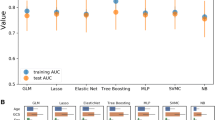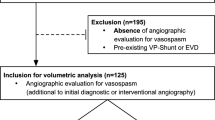Abstract
Background
When vasospasm is detected after aneurysmal subarachnoid hemorrhage (aSAH), it is treated with hypertensive or endovascular therapy. Current classification methods are resource-intensive, relying on specialty-trained professionals (nursing exams, transcranial dopplers, and perfusion imaging). More passively obtained variables such as cerebrospinal fluid drainage volumes, sodium, glucose, blood pressure, intracranial pressure, and heart rate, have not been used to predict vasospasm. We hypothesize that these features may yield as much information as resource-intensive features to classify vasospasm.
Methods
We studied data from 81 aSAH patients presenting within two days of onset. Vasospasm class (VSP) was defined by angiographic vasospasm warranting endovascular treatment. Naïve Bayes (NB) and logistic regression (LR) classifiers were trained on selected variable feature sets from the first three days of illness. Performance of trained classifiers was evaluated using area under the receiver operator characteristic curve (AUC classifier) and F-measure (F classifier). Ablation analysis determined incremental utility of each variable and subsets.
Results
43.2 % developed VSP. During feature selection, the only passively collected variable that did not yield a statistically significant summary statistic was CSF drainage volume. NB classifier trained on all passively obtained features (AUC NB 0.708 and F NB 0.636) outperformed NB classifier trained on resource-intensive features (AUC NB 0.501 and F NB 0.349).
Conclusions
Data-driven analysis of passively obtained clinical data predicted VSP better than current targeted resource-intensive monitoring techniques after aSAH. Automated classification of VSP may be possible.
Similar content being viewed by others
References
Connolly ES Jr, Rabinstein AA, Carhuapoma JR, Derdeyn CP, Dion J, Higashida RT, et al. on behalf of the American Heart Association Stroke Council, Council on Cardiovascular Radiology and Intervention, Council on Cardiovascular Nursing, Council on Cardiovascular Surgery and Anesthesia, and Council on Clinical Cardiology. Guidelines for the management of aneurysmal subarachnoid hemorrhage: a guideline for healthcare professional from the American Heart Association/American Stroke Association. Stroke 2012; 43:1711-37.
Weir B, Grace M, Hansen J, Rothberg C. Time course of vasospasm in man. J Neurosurg. 1978;48(2):173–8.
Hijdra A, Van Gijn J, Stefanko S, Van Dongen KJ, Vermeulen M, Van Crevel H. Delayed cerebral ischemia after aneurysmal subarachnoid hemorrhage: clinicoanatomic correlations. Neurology. 1986;36:329–33.
Roos YB, de Haan RJ, Beenen LF, Groen RJ, Albrecht KW, Vermeulen M. Complications and outcome in patients with aneurysmal subarachnoid haemorrhage: a prospective hospital based cohort study in the Netherlands. J Neurol Neurosurg Psychiatry. 2000;68:337–41.
Vergouwen MD, Vermeulen M, van Gijn J, Rinkel GJ, Wijdicks EF, Muizelaar JP, et al. Definition of delayed cerebral ischemia after aneurysmal subarachnoid hemorrhage as an outcome event in clinical trials and observational studies: proposal of a multidisciplinary research group. Stroke. 2010;41:2391–5.
Spann RG, Lang DA, Birch AA, Lamb R, Neil-Dwyer G. Intra-aortic balloon counterpulsation: augmentation of cerebral blood flow after aneurysmal subarachnoid haemorrhage. Acta Neurochir (Wien). 2001;143:115–23.
Lazaridis C, Pradilla G, Nyquist PA, Tamargo RJ. Intra-aortic balloon pump counterpulsation in the setting of subarachnoid hemorrhage, cerebral vasospasm, and neurogenic stress cardiomyopathy. Case report and review of the literature. Neurocrit Care. 2010;13(1):101–8.
Sloan MA, Alexandrov AV, Tegeler CH, Spencer MP, Caplan LR, Feldmann E, et al. on behalf of the Therapeutics and Technology Assessment Subcommittee of the American Academy of Neurology. Assessment: transcranial Doppler ultrasonography: report of the Therapeutics and Technology Assessment Subcommittee of the American Academy of Neurology. Neurology 2004; 62:1468-81.
Sloan MA, Haley EC Jr, Kassell NF, Henry ML, Stewart SR, Beskin RR, et al. Sensitivity and specificity of transcranial doppler ultrasonography in the diagnosis of vasospasm following subarachnoid hemorrhage. Neurology. 1989;39:1514–8.
Friedman D, Claassen J, Hirsch LJ. Continuous electroencephalogram monitoring in the intensive care unit. Anesth Analg. 2009;109:506–23.
Claassen J, Taccone FS, Horn P, Holtkamp M, Stocchetti N, Oddo M. Recommendations on the use of EEG monitoring in critically ill patients: consensus statement from the neurointensive care section of the ESICM. Intensive Care Med. 2013;39:1337–51.
Mayberg MR, Batjer HH, Dacey R, Diringer M, Haley EC, Heros RC, et al. Guidelines for the management of aneurysmal subarachnoid hemorrhage: A statement for healthcare professionals from a special writing group of the Stroke Council, American Heart Association. Stroke. 1994;25:2315–28.
Bederson JB, Connolly ES Jr, Batjer HH, Dacey RG, Dion JE, Diringer MN, et al. Guidelines for the management of aneurysmal subarachnoid hemorrhage: a statement for healthcare professionals from a special writing group of the Stroke Council, American Heart Association. Stroke. 2009;40:994–1025.
Russell S, Norvig P. Artificial intelligence—a modern approach. 3rd ed. New Jersey: Pearson Education; 2010. p. 726–808.
Hall M, Frank E, Holmes G, Pfahringer B, Reutemann P, Witten IH. The WEKA data mining software: an update. SIGKDD Explor. 2009;11(1):10–8.
Ng AY, Jordan M. On discriminative vs. generative classifiers: a comparison of logistic regression and naïve Bayes. Neural Inf Process Syst. 2001;14:841–8.
Zhang H. The optimality of naïve bayes. In: Barr V, Markov Z, editors. Proceedings of the Seventeenth International Florida Artificial Intelligence Research Society Conference FLAIRS. Miami Beach: FL, AAAI Press; 2004. p. 562–7.
Acknowledgments
This research was supported in part by the Penn Medicine Neuroscience Center (SP) and the National Science Foundation CNS- 1035715 (AR, IL).
Conflict of interest
Alex Roederer, John Holmes, Michelle Smith, Insup Lee, and Soojin Park declare that they have no conflicts of interest.
Author information
Authors and Affiliations
Corresponding author
Rights and permissions
About this article
Cite this article
Roederer, A., Holmes, J.H., Smith, M.J. et al. Prediction of Significant Vasospasm in Aneurysmal Subarachnoid Hemorrhage Using Automated Data. Neurocrit Care 21, 444–450 (2014). https://doi.org/10.1007/s12028-014-9976-9
Published:
Issue Date:
DOI: https://doi.org/10.1007/s12028-014-9976-9




